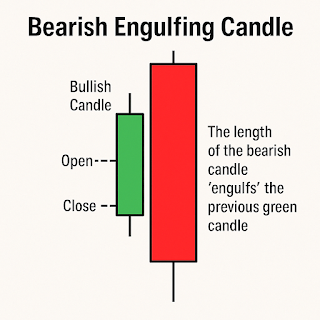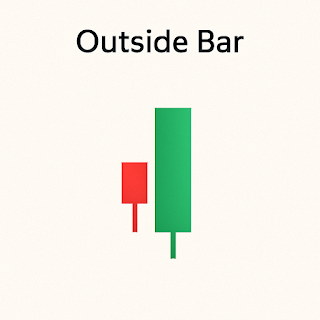Most traders memorize candlestick patterns without understanding the psychology behind them. That’s why they fail. The Candlestick Bible goes deeper—showing that each pattern is a snapshot of market sentiment and crowd behavior.
Below are the most important candlestick patterns and their true meanings, as interpreted through the strategy trader’s lens.
1. Bullish Engulfing
Structure: A small bearish candle followed by a larger bullish candle that completely engulfs it.
True Meaning:
Buyers overwhelmed sellers in a single push. This is not just “reversal”—it’s a shift in power. The prior selling pressure has been absorbed, and new demand has entered aggressively.
Strategic Use:
Only valid after a downtrend or deep pullback, especially at RSI cold levels or near a support zone. Volume should expand with the engulfing.
2. Bearish Engulfing
Structure: A small bullish candle followed by a larger bearish candle that fully engulfs the previous one.
True Meaning:
Buyers got overpowered. This shows loss of confidence and rejection of higher prices. Someone just dumped size—fast.
Strategic Use:
Stronger when forming at RSI heat zones, Bollinger Band tops, or previous resistance. Look for fading volume or climax volume into the engulfing.
3. Hammer (Pin Bar / Long-Lower Wick)
Structure: Small candle body near the top, long lower wick.
True Meaning:
Price was aggressively rejected at lower levels. Sellers tried to push down but got absorbed and reversed by demand. It’s a defense.
Strategic Use:
Valid after sharp drops. Use it near support zones or mean deviation lines. Volume should show signs of stopping power or absorption.
4. Shooting Star
Structure: Small body near the bottom, long upper wick.
True Meaning:
Buyers pushed price up but failed to hold. Rejection at the highs signals that there’s no real strength behind the rally.
Strategic Use:
Often appears after a spike. Stronger at hot RSI levels or after weak momentum rallies. Look for volume to spike on the wick.
5. Doji
Structure: Open and close are very close or equal; small or no body.
True Meaning:
Indecision. Neither buyers nor sellers were able to take control. It’s not a signal—it’s a pause in market conviction.
Strategic Use:
Doji becomes powerful when it confirms existing signals—like forming after a strong move, or at the end of a trend. Used best as part of a multi-candle formation.
6. Inside Bar
Structure: A candle completely inside the range of the previous candle.
True Meaning:
Consolidation. The market is coiling, building energy before the next move. It’s a reset of volatility.
Strategic Use:
Inside bars can signal breakout setups. Ideal after impulsive candles. Look for them within trend continuation or before major market opens.
7. Outside Bar / Outside Reversal
Structure: A candle that exceeds both the high and low of the previous candle and closes in the opposite direction.
True Meaning:
Fakeout and reversal. Price attempted to continue in one direction but was reversed violently. This often clears stop losses before reversing.
Strategic Use:
Shows up frequently as part of algorithmic trap behavior. Watch for them at Bollinger Band extremes or after volume spikes.
8. Three Inside Up / Down
Structure (Up): Bearish candle → small bullish candle inside → bullish breakout candle
Structure (Down): Bullish candle → small bearish candle inside → bearish breakout candle
True Meaning:
This is a measured shift of control—not sudden. It shows a calculated reversal as the market transitions between hands.
Strategic Use:
Look for these on higher timeframes for added strength. Works well when confirming divergence signals on RSI or MACD.
9. Tweezer Tops & Bottoms
Structure: Two candles with similar highs (top) or lows (bottom), often with opposite directions.
True Meaning:
Market tested the same level twice and failed both times. Either buyers or sellers are defending that level aggressively.
Strategic Use:
Best used at key levels. Look for confirmation with volume tapering or RSI pivoting away from overbought/oversold.
10. Marubozu
Structure: Large full-bodied candle with little to no wick on either side.
True Meaning:
One-sided dominance. Either bulls or bears controlled the entire candle without challenge. This is momentum in its purest form.
Strategic Use:
Should only be chased if part of a breakout or continuation. Otherwise, it may be exhaustion. Watch the next candle for follow-through or trap.
How to Use Candlestick Patterns Like a Strategy Trader
You don’t trade a pattern. You trade the energy it represents.
Here’s the process:
- Establish Context – Use RSI, volume, moving averages, or volatility compression to identify the environment the candle lives in.
- Look for Meaningful Formations – Not every pin bar is a trade. But when it's at the edge of a range, with a trap wick and volume confirmation—it matters.
- Confirm With Structure – Break of the candle’s high/low, shift in volume, or break of a micro range gives you your entry logic.
- Risk is Based on the Candle – The pattern gives you natural stop loss zones (e.g., the wick on a pin bar). Use them.
Final Thought
The Candlestick Bible is not about patterns—it’s about psychology in motion. Each candle is a reflection of conflict. Your job isn’t to memorize every name—it’s to interpret what emotion created that shape, and how it fits into the larger picture.
Gamblers trade signals. Algos trade code. But strategy traders trade energy and sentiment.
That’s the true power of the Candlestick Bible.
Let me know if you'd like this article optimized for print, turned into a PDF, or expanded into a lesson series.
.png)








.jpg)

